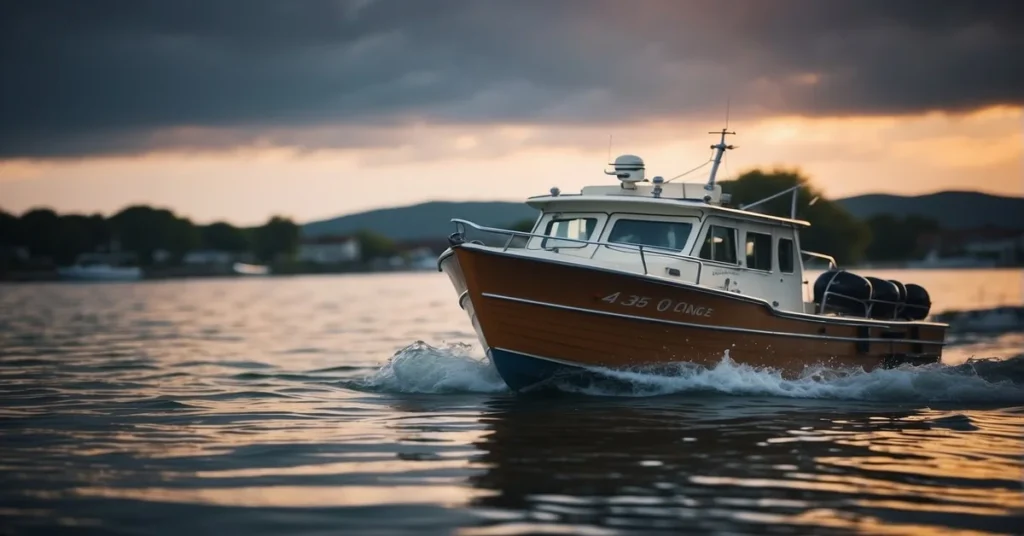
Sailing the seas can be a blissful experience, but it’s crucial to navigate carefully to keep it that way. That’s why mastering How To Avoid Colliding With Another Boat is essential for every skipper’s skillset.
Prepare to sail on a journey through the best practices and savvy strategies that will keep your boating adventures as safe as they are exhilarating!
My 5 Best Tips to Avoid Colliding With Another Boat
When I’m out on the water, one of my foremost thoughts is to avoid colliding with another boat. It’s an essential aspect of safe boating, and knowing the essentials that can’t be overlooked. So, here are five tips I’ve gathered to help keep your boating experience collision-free.
- Maintain a Proper Lookout
- Always be observant of what’s ahead and around your vessel.
- Use binoculars for better vision.
- Understand and Follow Navigation Rules
- Learn the ‘rules of the road’ including right-of-way protocols.
- Tip: Slower boats should not impede the path of faster vessels.
- Communicate Effectively
- Keep the radio on and monitor for any alerts or communication.
- Please familiarize yourself with sound signals and their meanings; for example, one short blast indicates a pass on my port side.
- Adapt to Conditions
- Reduce speed in poor visibility or high traffic.
- Be extra cautious at night or in fog.
- Use Available Technology
- Equip your boat with radar or AIS to identify and track nearby vessels.
- Regularly check these systems for accuracy.
By sticking to these strategies, I’ve found that I enjoy a safer boating experience. Remember, it’s all about being prepared, informed, and attentive to ensure a pleasant time on the water for everyone. Thats how we will Avoid Colliding With Another Boat.
Fundamentals of Safe Boating

To effectively avoid colliding with another boat, there are core principles I always keep in mind. Each aspect is crucial for a safe voyage, from understanding navigation rules to maintaining a vigilant lookout.
Understanding the Right of Way
The “right of way” is a fundamental concept in the water that helps prevent collisions. In boating terms, this means knowing whether my vessel is the give-way vessel (required to take early and substantial action to avoid collision) or the stand-on vessel (maintaining course and speed).
With sailboats, the right of way is generally given to the vessel with the wind on the port side, and among power-driven boats, it’s similar to the rules of the road – the vessel approaching from starboard has priority.
Importance of a Proper Lookout
Maintaining a proper lookout is essential to safe boating. I ensure that someone is always assigned to observe the surroundings, including other vessels, navigation aids, and potential hazards. A keen situational awareness helps avoid collisions, especially in conditions of limited visibility, such as fog or at dusk.
Navigating with Care
I am conscientious about adhering to marine navigation rules and familiarizing myself with applicable speed limits. It’s not just about following a chart or GPS; it’s about observing the water and weather conditions, which can change rapidly. Practicing caution at all times and adjusting speed accordingly keeps my boat and crew safe.
Communication on the Water
On the water, communication methods like VHF radio, visual signals, and especially sound signals are vital for conveying my intentions to other boaters. For example, one short horn blast signals my plan to alter course to starboard, helping others understand my actions to avoid misunderstandings and potential collisions.
Accident Prevention and Response

Regarding boating, I understand the serious commitment to safety and the unwavering dedication needed to avoid colliding with another boat. It requires a proactive approach and the right knowledge to manage risk factors effectively.
Speed Management
Managing speed is the cornerstone of safe boating. I ensure that my vessel operates at safe speeds that match the conditions of the waterway. This means keeping below speed limits and reducing speed in high-traffic areas or under poor visibility conditions. It’s not just about preventing accidents; staying within the recommended speed helps to mitigate the consequences should an incident occur.
Staying Visible
Visibility on the water can differ between a pleasant day out and a disastrous one. I make it a point to ensure my running lights are operational, especially from dusk to dawn and during periods of reduced visibility. Additionally, using a radar reflector and setting up an AIS (Automatic Identification System) enhances the detection of my boat by others, helping me stay visible to surrounding vessels.
Handling Emergencies
Having an emergency plan and communication protocol in place is crucial. I maintain a clear line of communication with my crew and ensure everyone knows how to signal for help. We regularly check our safety equipment, and I know how to send a distress signal to emergency services like the US Coast Guard in case we find ourselves in an unexpected situation.
Boating Under the Influence
Boating under the influence is a serious risk that I never take. I stay sober while operating my boat, to ensure I’m able to make quick decisions without the impairing effects of alcohol. As the skipper, my responsibility is to promote safe boating by ensuring my crew and passengers understand the importance of staying sober on the water.
FAQ – How To Avoid Colliding With Another Boat

Do you have questions on dodging danger in the deep blue? Our FAQ is your go-to guide on How To Avoid Colliding With Another Boat – let’s keep those waters safe together!
Who is responsible for avoiding a collision between two vessels?
It is every vessel operator’s responsibility to avoid a collision. To prevent a collision, boat and PWC operators should: Follow the rules of navigation. Pay attention to navigational aids.
How can ship collisions be avoided?
Always maintain a watch.
Understand marine navigation rules.
Stay clear of shipping lanes.
Understand the implications of speed.
Remain visible at all times.
Keep your VHF radio on underway.
Only boat when well-rested and sober.
Expect the unexpected.
What is the general rule of collision avoidance?
The bottom line on collision avoidance is that it’s the pilot’s responsibility to “see and avoid” other aircraft, as laid out in FAR 91.113(b)
Set your course for discussion and share your own navigational wisdom below – how do you steer clear of trouble on the high seas? Comment with your strategies for avoiding boat collisions!

